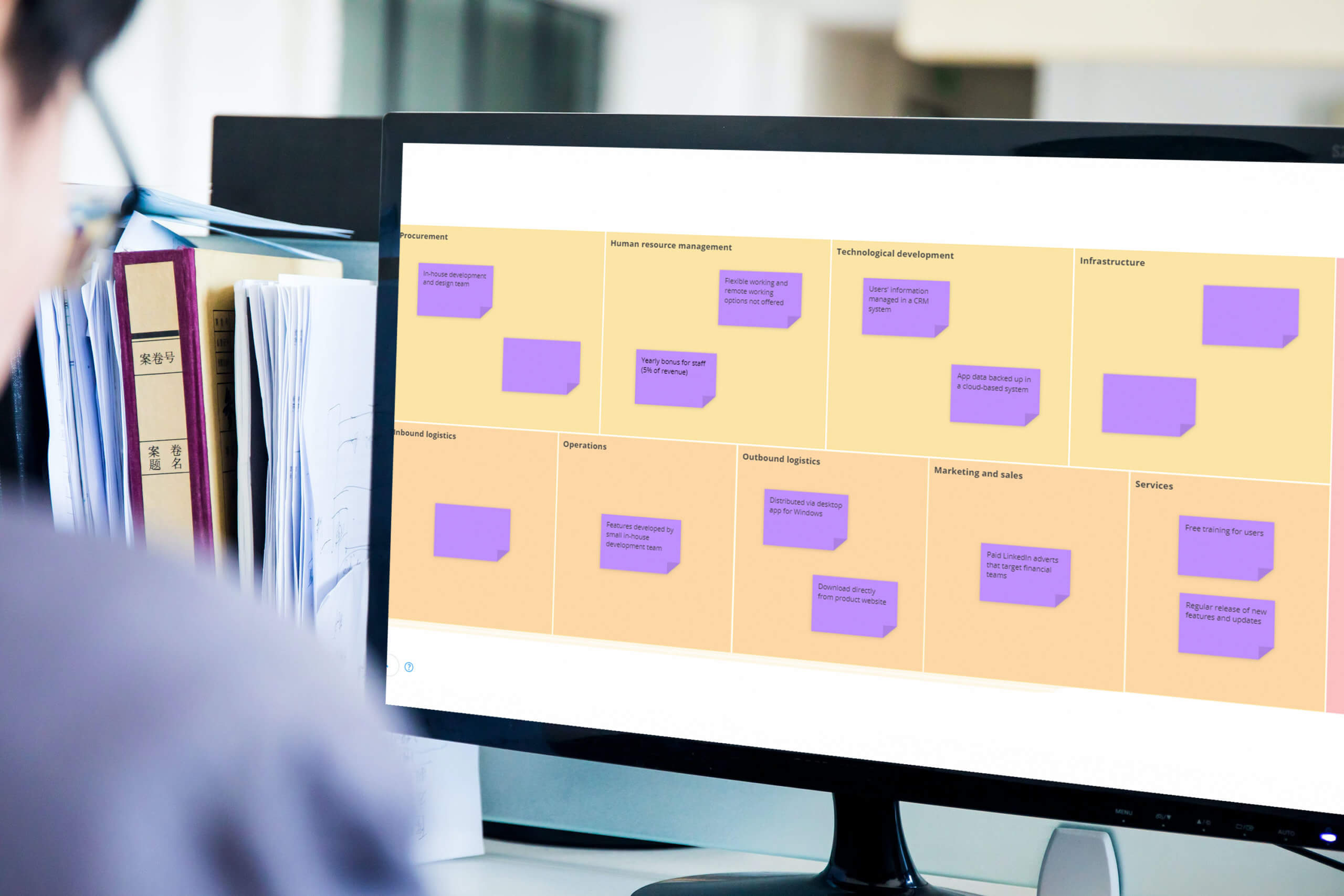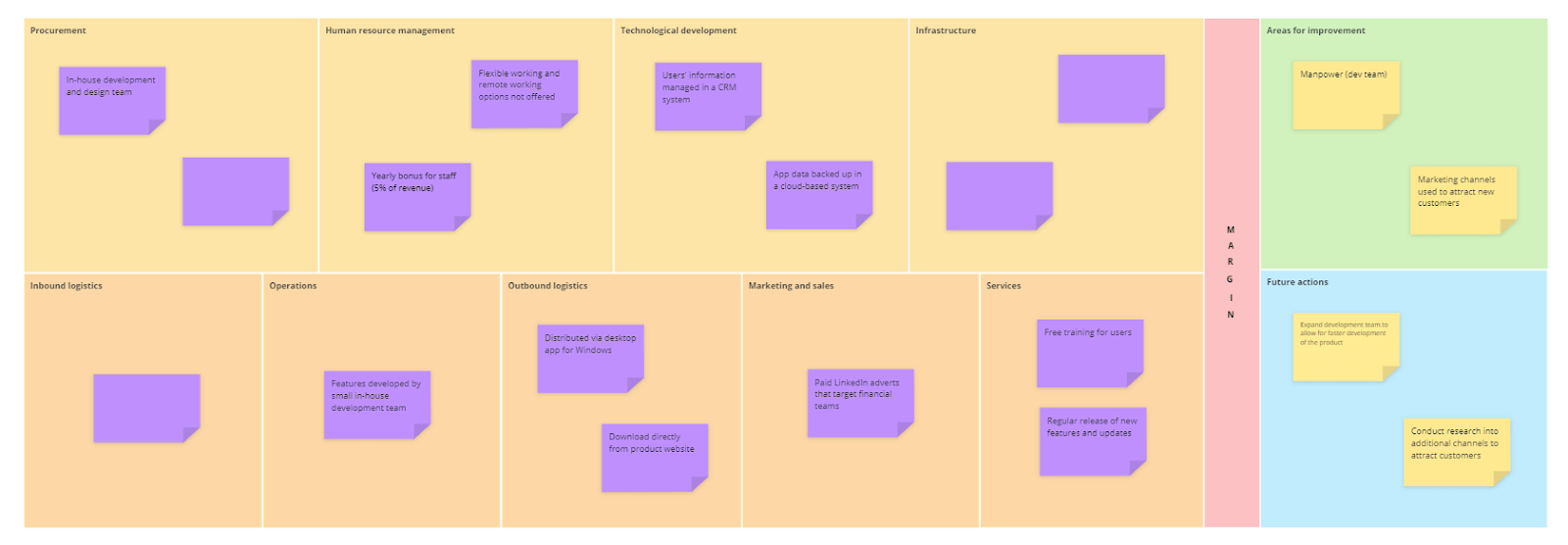February 19, 2021 (Updated February 23rd, 2023)
The simple way to conduct a Value Chain Analysis

Creating value for their customers is something that every business strives to achieve as it can help you to gain a competitive advantage over others in your market. However, it’s vital to ensure that this value isn’t coming at a great cost to your business. Conducting a Value Chain Analysis will help you examine whether your business’s outputs generate a greater value than the costs of creating them, so you can ensure that you are producing the best possible profit margin.
A Value Chain Analysis is one of the most important strategy tools for businesses to determine whether they are actually profitable and help them stand out from their biggest competitors. It requires you to examine your organization’s external activities when creating, marketing and distributing a product or service offering, so you can recognize which activities are bringing the most value and which can be improved upon. For this reason, a Value Chain Analysis can help your business to create a more competitive strategy going forward.
This concept was originally discussed by the Harvard University Professor, Michael E. Porter, in his 1985 book, Competitive Advantage, in which he also introduced the idea of the ‘value chain’. With a value chain being comprised of the activities a business undertakes to deliver a product to its customers and demonstrating how these activities are connected, a Value Chain Analysis will help you understand the value each of them brings to the process.
So, what goes into conducting a Value Chain Analysis and how can you make this process as simple as possible?
What is a Value Chain Analysis?
A Value Chain Analysis might seem complex at first glance, but it is fairly straightforward when you know what steps are involved in actually conducting one. Instead of analyzing the costs of entire departments, Porter’s model instead focuses on individual activities and seeing how they are connected. For this reason, conducting a Value Chain Analysis is a great way of identifying which aspects of your process are actually generating value.
However, the key aim of carrying out a Value Chain Analysis is to help your business create a competitive advantage, and this is something you should keep in mind throughout the process of conducting one. According to Porter, there are two basic types of competitive advantage an organization can gain; Cost Leadership (or low cost) and Differentiation.
- A Cost Leadership strategy involves reducing the cost of materials and other resources to offer your product or services for the lowest price in your chosen market.
- A Differentiation strategy will focus on producing a unique or highly specialized product or service. As a result, they will typically require a higher price point due to the amount of time and money that will need to be invested into creating it.
Conducting this analysis will help you to determine which competitive strategy your business will use going forward, and you should keep this in mind when examining your business activities as part of the analysis.
Porter’s Value Chain Analysis model requires you to split your business activities into two types; primary activities and support activities (which are outlined in more detail below). Identifying which of these categories your business activities fall into is the first step of conducting a simple, yet effective Value Chain Analysis.
Primary activities
Primary activities are made up of five activities that directly relate to the creation of your product or service offering, as well as the maintenance and promotion of it. These include:
- Inbound logistics: processes relating to how resources and materials (if applicable) are sourced for the product to be developed and distributed.
- Operations: activities that enable inputs to be turned into outputs (for example, how the materials and resources are produced and turned into the final product).
- Outbound logistics: this describes how the finished product or service will be delivered to customers. This includes collection and storage, as well as distribution systems.
- Marketing and sales: the ways you communicate with your target audience to promote your product or service offering to them. Services: any activities relating to maintaining the value of your product or service after the customer has purchased them (such as training and warranties).
Support activities
Support activities directly support the primary activities and help them to create additional value over your competitors. The four types of support activities include:
- Procurement: how your company sources the resources needed to operate and create its products and services. This includes finding high-quality, but cost-effective suppliers.
- Human resource management: this relates to your organization’s HR practices, such as how well you recruit, manage and retain your workers.
- Technological development: the ways you process and manage information and use technology to gain an advantage over your competitors (such as increasing efficiency).
- Infrastructure: the management, financial and legal systems that support your business in its everyday running.
How to conduct a Value Chain Analysis
Step 1: Identify your value activities and sub-activities
As we’ve already explained, the first step of conducting a Value Chain Analysis is defining any of your business’s support and primary activities that bring value, then determining which of the categories they fall under. Remember, these are any activities that are involved in any stage of the process of developing your product or service.
Once you’ve identified which category each of your business activities falls under, the next step to getting your Value Chain Analysis firmly underway is to determine the sub-activities for each primary activity, then later, for each of your support activities. You will also need to consider how these sub-activities help to create additional value over your competitors.
When defining sub-activities for your primary activities, bear in mind that there are three types of sub-activities that these may fall into:
- Direct activities: any actions that create value in themselves, such as actively recruiting and training new employees. Indirect activities: any activities that support your direct activities and allow them to run smoothly (such as keeping records of training undertaken so far).
- Quality assurance: these activities ensure that the direct and indirect activities meet all necessary and required standards.
Now it’s time to identify any sub-activities that add value to your support activities (for example, how activities relating to human resource management can bring value to those that fall under the category of operations). It’s important to bear in mind that these may not be specific to just one category of primary activity, and are likely to be cross-functional.
If there are connections between your value activities, you should take the time to make a note of these when conducting your analysis. As an example, targeting the right audiences with effective adverts through the most appropriate marketing channels can increase the number of sales you generate.
Step 2: Analyze the cost of your activities
When you have a list of all your business activities mapped out, you will need to work with your team to brainstorm ways that they each bring value for your customers, as well as the business as a whole. When doing this, consider the costs of carrying out each activity (not just in terms of monetary value, but in labor and manpower), so you can determine if they are cost-effective – if not, you can identify them as an area that needs improvement.
When assessing the value of your activities, remember to keep the competitive advantage you want to achieve firmly in mind.
Step 4: Look for opportunities to gain additional value
The Value Chain Analysis you created should be able to show you which activities are actively bringing value for your customers and overall business, as well as being the most cost-effective. It should also show you which activities will need improvement due to a lack of value or efficiency. You can then use this information to devise a strategy to improve your business processes and ensure that every action your organization takes is generating results.
Tips to conduct a Value Chain Analysis in Ayoa
In Ayoa, our collaborative whiteboards are an effective tool to conduct an in-depth Value Chain Analysis due to the great level of flexibility they offer. Starting with a blank canvas, you can use elements such as sections, shapes and freestanding text to create the categories you need for each step for your Value Chain Analysis. Putting it into a highly visual format will also boost your ability to think of ideas – and make this information easier to process and analyze when needed.
Once you’ve created a section for each step of the process, all you need to do is use elements like sticky notes and lists to add your ideas to the whiteboard! Once you’ve identified any areas for improvement during the analysis of your business activities, you can use Ayoa’s built-in task management features to turn these ideas into actionable tasks.
What if I would rather use a template?
To make this process even quicker and easier, we also offer a premade Value Chain Analysis template that can be accessed in the app. This is already divided into the sections you need to complete your analysis – all you need to do is fill out each of the template’s sections by adding your own ideas using sticky notes and lists.
It’s as simple as choosing the element you want to use, then dragging and dropping it onto your board. You can then add text and emojis, and change the size and color if needed. In fact, you may want to use different colored sticky notes for your primary and support activities and any of their related sub-activities, so you and your wider team can see at a glance which category your activities fall into!

When you’ve defined all of your activities, sub-activities and their value, plus identified links between your activities, it’s time to plan what improvements should be made to your business processes using the section provided. When you’re ready, create a task board to turn the actions you plan to take into actionable tasks with clear start and due dates. You can then assign these tasks to other members of your team, track your progress on each task using visual progress indicators, and attach documents, notes, comments, checklists and other vital information.
Ready to get started with our Value Chain Analysis template? Just sign up for free, open the homepage in the app, then click on the blue ‘Create whiteboard’ button. You will then be able to find the template in the list that appears.
When you’ve located the template, the next step is pretty simple. Click on the template in the list, then on the ‘create whiteboard’ button at the bottom of the pop-up window. You will then be given the option to name your board, add a description, invite other Ayoa users, and create a corresponding task board at the same time. This last option enables you to open your new task board and whiteboard alongside each other and easily drag and drop your sticky notes into it – which will turn them into actionable tasks you can manage.
If you want, you can choose a premade task board template to make this process even easier, as these already include categories for you to add your tasks into. However, you can also create a blank task board later which can be opened alongside your whiteboard using the ‘Task Bar’ option in the bottom left-hand corner of the app.
There’s no need to save your new whiteboard or task board when you’re done editing and wish to close it – any changes you make will be saved automatically! You can then refer back to your boards whenever you need to, make edits, and share it with other users by giving them access.
Ready to transform your business processes and give yourself an advantage over your biggest competitors? Sign up to Ayoa for free today to conduct your own effective Value Chain Analysis and devise an actionable strategy that will generate great results – then track your progress at every step of the way.

